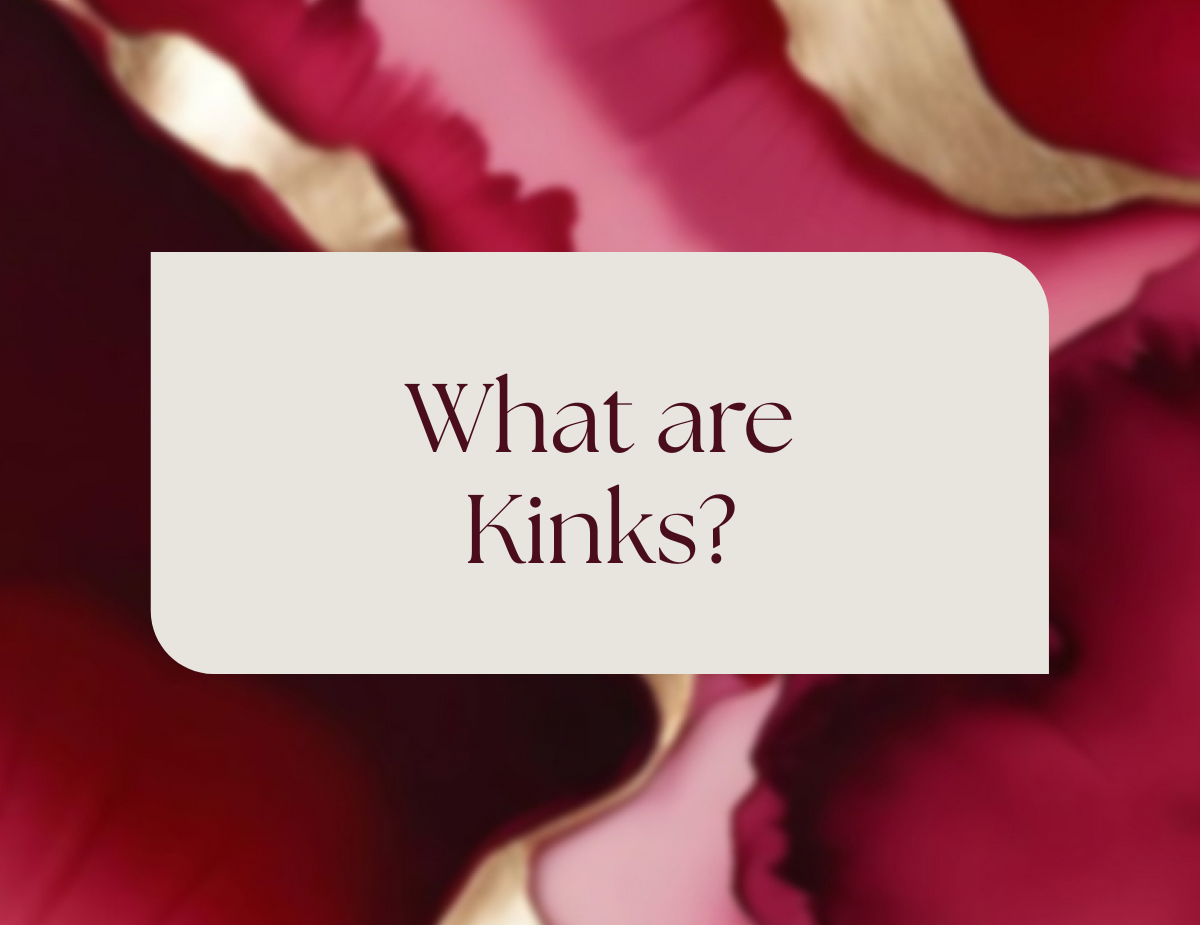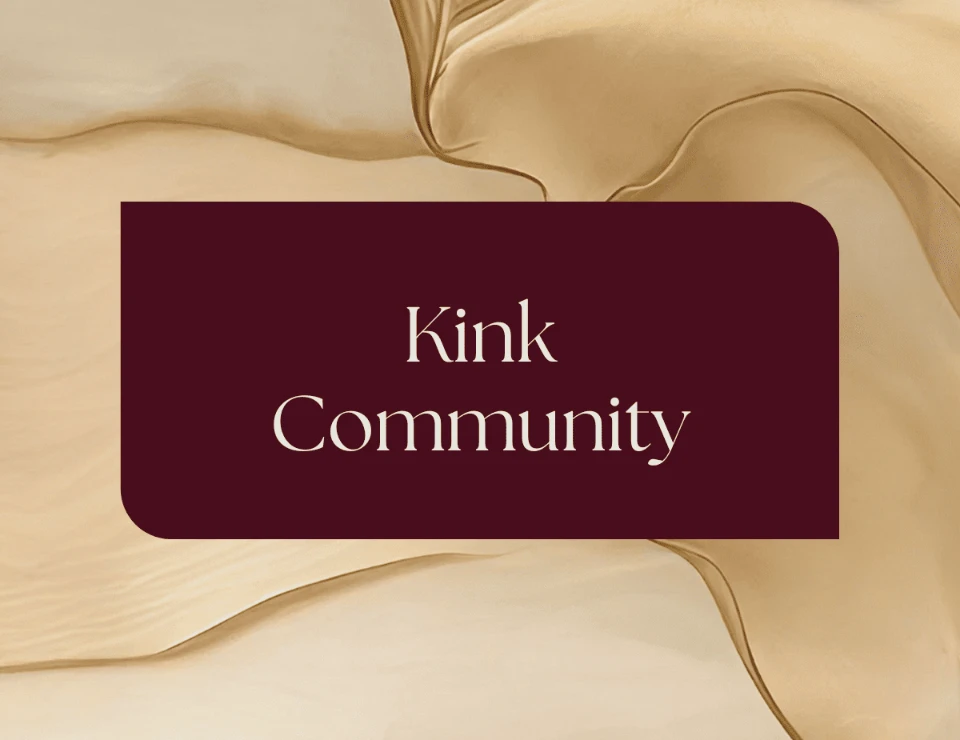What are kinks? What does being kinky mean? What is kinkyness? Well, you’re definitely in the right place to find out. We’re covering what kinks are and how you can explore them, no matter what stage of your kink journey you’re at. We’ll keep the exploration of kinks approachable and grounded in consent for consenting adults, celebrating that sexual activities and sexual desires can be an important part of life for different people.
What are kinks?
Kinks are an umbrella term for sexual preferences, sexual activities, and sexual practices that sit outside of what society typically sees as “vanilla” or conventional sex.
Kinks can include a wide range of sexual desires, from enjoying certain power dynamics to exploring specific sensations, fantasies, or sexual play. They can be about intimacy, identity, curiosity, role play, or all of the above. They are a broad spectrum of kinks that help different people explore different aspects of their sexuality, forming an integral part of our sexual identities.
In short? Kink is about tuning into what turns you on (yes, even if you don’t know what that is yet). For some, that looks like role-playing or erotic role-playing; for others, it’s simply noticing what brings sexual pleasure, sexual arousal, or better sex. This might include physical objects like sex toys, sensual props like sex candles, or even more elaborate scenes involving BDSM.
Some people discover their kinks early on. Others find them through exploration, media, or conversations with trusted partners. There’s no one way or timeline to uncover what excites you, just your own unique path and your own unique set of pleasures. And because the world of kinks includes a complex assortment of sorts, from gentle bondage to intense forms of play, there’s space for everyone’s curiosity.
A brief history of kink
Kink isn’t new. People have been playing with power, sensation, and fantasy for centuries, from ancient rituals to Victorian role-play (yes, really).
Historical records show people engaging in everything from ceremonial flogging to elaborate scenes of BDSM, sensory play, or dress-up. Examples of kinks can be found in mid-20th-century English-speaking cultures and earlier, and the appeal of fetishism has been recorded across many Western societies.
In more recent decades, kink communities began to organise more formally (thankfully).
Events like play parties, munches*, and workshops created spaces for people to connect, learn, and explore in safer, more structured ways.
Modern research on Kink
There’s been lots of brilliant research, too, such as the Kinsey Reports and modern studies by sex educators. Clinical sexologist Rena McDaniel, and psychological researcher Samuel Hughes have helped document kinky identities, sexual behaviour, and the acceptance of kink.
Professionals like psychologist Dr. Linda Blair and sex researchers like Dr. Justin Lehmiller shed light on how a person’s unusual sexual interest or specific attractions might develop over time, sometimes linked to memories of some past adventurous nights or even childhood memories.
The word kink in everyday speech has evolved, influenced by popular culture and the growing kink community. And now, thanks to the internet, a celebration of queer perspectives, and a growing movement around sex-positivity, kink has more visibility and less stigma than ever before, particularly in Western societies.
This shift has opened the door for a broader spectrum of unconventional practices and a myriad of options for exploring sexual expression.
(*Munch: A casual social gathering for kink-curious or experienced people, usually held in public venues like cafes or pubs, and not involving any play.)
So what about Kink misconceptions and stereotypes?
Let’s clear a few things up. A common misconception is that kink is always rough, extreme, or about whips and chains (unless that’s your thing). It isn’t always about pain or dominance. And it definitely isn’t something to be ashamed of.
In reality, kink can be soft, slow, silly, sensual, emotional, or empowering. It’s as varied as the people who practice it, from light bondage to gentle bondage, from praise kink to more intense forms of play like piss play, Blood play, or a foot fetish. For some, it might mean experimenting with gag kink, sound kink, or pantyhose fetish. Just because something turns you on doesn’t mean it has to make sense to anyone else - the most important thing is that it happens in a consensual erotic context between consenting adults.
Kink is often misunderstood because it challenges what is seen as normative sexual behaviour. That’s why education and an open mind matter. Such discussions make space for curiosity, safety, and the importance of consent.
The word kink in everyday speech can mean different things to different people, but at its core, it’s about sexual acts or sexual activity that exist outside conventional norms. In the realm of kink, those activities may range from toy play to the mutual creation of a shared fantasy.
It’s personal to you. And that’s what makes it so exciting.
What different types of kinks are there?
If we were to go through a complete guide or list of kinks covering every single type that exists, we’d be here forever (that would be a lot of fun). So here is a short look at some popular kinks and the most common kinks you might want to hear more about. This is not a comprehensive list, just a few examples of kinks.
Sensation and impact play
Sensation play, sometimes called sensory play, involves stimulating the senses in different ways, think feathers, ice cubes, blindfolds, or soft touch. Some people also enjoy sex toys, common toys, or toy play in a consensual erotic context. It’s about enhancing awareness and anticipation. Some people love the feeling of contrast, hot and cold, soft and sharp, light and heavy.
Impact play includes spanking, flogging, or paddling, but it’s never about causing harm. It’s about creating sensation in a way that’s agreed upon, safe, and often deeply bonding. Some enjoy the build-up and the sound of your partner hitting as part of the scene, while others add sound effects or sex candles for atmosphere.
Power dynamics
One of the most well-known kinks involves power play like Dominance and submission (D/s). This can be subtle or explicit and doesn’t always include sexual acts. Sometimes, it’s about who gives the instructions and who follows them, or how authority, care, or control is shared between partners. This world of dominance and submission can include a submissive partner, partner service, or committed power exchange relationships with total control.
These dynamics are always consensual. They often include rituals, agreements, or elaborate scenes that create emotional safety and deep trust. For some people, power exchange is a meaningful part of identity and relationships. For others, it’s an occasional form of play.
Role-play and fantasy
Role play and fantasy, including role-playing, erotic role-playing, and specific types of roleplay, let people explore characters or scenarios that feel exciting or meaningful. This could involve a student scenario, a chosen animal characterised pet play, or the nurturing aspects of a doctor. The point isn’t perfect acting; it’s exploring a particular sexual curiosity or creating a consensual erotic context. You might even bring in physical objects or well-sterilised objects for safety.
Fetishes and specific interests
A fetish is a strong turn-on for a specific object, material, or body part like latex, lingerie, or feet. A foot fetish, pantyhose fetish, nipple kink, or hidden kink are just some examples of kinks that centre on specific attractions. These might stem from childhood memories, cultural influence, or a person’s unusual sexual interest. They can bring great pleasure, sexual gratification, and positive effects to those involved.
Sensory deprivation play
This kink category includes play around the senses, whether that’s blindfolding, using headphones, or restricting movement. Taking away one sense can heighten others, creating deeper focus and emotional intensities. This can be part of light bondage or gentle bondage, and often creates safe zones for exploration.
Bondage
Bondage involves the use of bondage tools like ropes, cuffs, or tape. For some, it’s about the physical sensation of being held; for others, it’s about surrender, trust, or control. That might be light bondage for beginners, or the use of bondage in more elaborate BDSM scenes. It can also include partner wear hosiery, an array of other delights, or even themed Porn-Date Night Idea setups.
Exhibitionism and voyeurism
Exhibitionism is the enjoyment of being seen, whether that’s being watched during sex, wearing something revealing, or simply feeling exposed. Voyeurism is the flip side: finding excitement in watching others. Voyeurism kink centres can be part of a safe space where everything is pre-agreed between equally game partners.
And that’s just the beginning...
There are also kinks that are more emotional or sensory than physical. Some people enjoy routines and structure through protocol play, or feel a thrill from denial and delayed gratification. Others are turned on by specific scents, accents, Dirty talk, or voices, or being in roles like a caregiver or service submissive.
Kinks like confession, humiliation kink, objectification (in a safe space and agreed-upon context), or breath play show that kink is just as much about the mind as it is the body. You might even explore stages of kink identity development, where your interests grow from Beginners’ Guide level experiences to a broader spectrum of unconventional practices.
Kink is personal and ever evolving…
Kink is anything that feels erotic, exciting, or fulfilling to you, especially if it sits outside of what you consider “normal” or everyday. Yes, we’ve defined what “kinks” are, but realistically, there’s no universal textbook definition. If vanilla sex isn’t your usual thing, that could feel kinky to you! It’s all relative. What matters most is that it’s consensual, safe, and brings you and your partner(s) joy or curiosity. Whether it’s about sensation, emotion, role, or ritual, if it turns you on and feels good, it’s valid.
For some, the most important things are trust and emotional connection; for others, it might be the thrill of a high-power scene or the care involved in nurturing aspects of a doctor role. You may even find that kink stems from earlier sexual experiences or certain social circles that shaped your relation to desire. In all cases, these are an integral part of our sexual identities.
How to explore kinks safely
So you want to explore kink? Wonderful. How can you explore it in the safest way? Here’s how to start.
Consent and communication
Kink only works when it’s built on trust. That starts with clear, open conversations about what you want to try and what you don’t. Always ask for consent. Always give it. The importance of consent is the most important thing in any consensual erotic context or consensual situation. Consent isn’t just a one-time agreement – it’s ongoing and can be withdrawn at any point.
You don’t need to have all the answers before starting the conversation. Saying “I’m curious about…” or “I’d like to try…” is enough. Give yourself permission to explore without pressure. Sometimes, this conversation might even involve a sex educator, sex therapist, sex coach, Leah Carey, or therapist Ashera DeRosa, especially if you’re unsure about boundaries or the different things you’d like to try. In some cases, psychological researcher Samuel Hughes or psychologist Dr. Linda Blair have highlighted how open communication supports mental health and safe exploration of sexual activities and sexual desires.
Setting boundaries
Boundaries are what help us feel safe. They’re not about restriction; they’re about creating a container for connection. Before exploring, talk about what’s okay, what’s not okay, and what needs extra care. Boundaries can be physical, emotional, or situational. You can also set boundaries around roles, language, or emotional states.
For instance: “I’m okay with spanking, but only with a paddle,” or “I want to avoid any humiliation kink tonight.” Boundaries are a crucial aspect of safety in the realm of kink, especially when exploring BDSM, sensory play, sexual play, or more unconventional sexual tastes like piss play or Foot fetish scenarios. These agreements are what keep the kink community safe, inclusive, and supportive for different people with specific attractions and a broad spectrum of kinks.
Safe words and stop mechanisms
A safe word is a pre-agreed word or signal that means “stop immediately.” It’s often something unrelated to the play, like “red” or “pineapple,” easy to remember and impossible to misinterpret. These words protect everyone and show that care is part of the play, not outside of it.
Some dynamics also use a traffic light system:
Green = keep going
Yellow = slow down / check-in
Red = stop completely
It’s helpful to review these before play and to check in after using them. A safe word isn’t a failure. It’s a communication tool, one that shows mutual respect and attention.
Safe words are not solely for pain or BDSM. They can be used in any context – whether it’s role-playing, erotic role-playing, breath play, or even a gentle bondage scene. If you are exploring a new fantasy, kink, or sexual activity that you’re curious about but want that safety mechanism, communicate and agree on it with your partner beforehand.
Aftercare matters
Aftercare is the emotional or physical support people need after kink play. This could mean cuddling, space, reassurance, snacks, or a debrief. Everyone is different, so ask: What helps you feel comforted after play? For some, it might include sex candles, soft music, or even light conversation about memories of some past adventurous nights to help ground them.
Aftercare helps manage emotional drops, reestablish trust, and transition back to everyday life. It’s not just nice. It’s necessary. Think of it as the final step in a shared journey - one that supports mental wellbeing and can have positive effects on mental health. For some, it’s also a time to talk about what worked, what didn’t, and whether they want to explore new sexual desires or experiment with sensory play, toy play, or other sexual acts next time.
The benefits of exploring kink
Personal growth and self-discovery
Kink can reveal what brings you joy, great pleasure, sexual gratification, or a wide range of responses that support personal growth and self-understanding. It can deepen your relationship with yourself and your body (which, yes, is totally worth celebrating). By exploring your sexual desires without judgment, you open the door to more confidence, creativity, and self-knowledge.
Some people say kink helped them reclaim their bodies, explore sexual orientation, or process past experiences in a healing way. Others find that exploring a broad umbrella of interests in the diverse world of kinks can connect them to new social circles and help them understand their relation to sexual behaviour.
Enhancing connection
Whether solo or with a partner, kink can build deep trust, strengthen bonds in committed power exchange relationships, and open up new kinds of emotional intensities. It’s not always about the activity; it’s about how you share it, communicate, and care for each other. The vulnerability in kink often leads to honesty, clarity, and affection. You’re not just playing roles; you’re co-creating an experience. That can be powerful, even transformative.
Normalising desire
Let’s be honest, most of us have some kind of fantasy, curiosity, or turn-on that’s been judged or dismissed. Exploring kink helps strip away shame and replace it with understanding and joy. Desire isn’t something to hide from — in fact, sexual pleasure is an important part of life and an integral part of our sexual identities. By engaging in the exploration of kinks, you’re also challenging norms about what sex “should” be. You’re directly tackling the shame and taboos in today’s world by personally exploring (kind of empowering, right?).
Kink challenges: what gets in the way?
Thinking about kink can bring up fears, insecurities, or internalised shame. Here are some common challenges and how to move through them.
Stigma and shame
Many people grow up being taught that kink is "wrong" or "weird." That can make even the idea of exploring it feel scary. But shame thrives in silence. Talking about kink in safe, open communities helps break those old narratives.
You deserve to explore what excites you without judgment. And if you’re carrying shame, you’re not alone. There’s support. There’s healing. And there’s joy on the other side.
Incompatibility between partners
Not every sexual partner will share your kinks. That doesn’t mean someone’s wrong. It means communication is key. You might need to find a middle ground, learn together, or explore solo.
Some people discover new desires by listening to their partner’s turn-ons. Others realise they’re more compatible with different kinds of partners. Either way, honesty and compassion matter more than matching fantasies.
(Solo kink is still kink.)
Mental health and triggers
Kink can be emotional. Sometimes, it surfaces unexpected feelings or trauma. That’s why it's important to go slow, be gentle, and check in with yourself. If something brings up difficult emotions, that doesn’t mean you’ve failed. It just means you need care and maybe a bit more support.
It can help to talk to a kink-aware sex therapist, especially if you’re navigating past trauma, anxiety, or big shifts in identity. Kink isn’t therapy, but it can be therapeutic. The key is knowing your limits and seeking help when needed.
Resources to help you explore kink safely
Books, blogs, and therapists
There’s a growing world of trusted resources out there. Start with books like Come As You Are by Emily Nagoski or Playing Well with Others by Lee Harrington. Sex therapists can also be a safe space to talk through your journey and help you unpack sexual desires, preferences, and various activities you may want to try.
(Sex therapist: A professional trained to support people with sexual health, identity, and intimacy issues.)
Finding community
You’re not alone. Whether through online forums, local meet-ups, or kink community events, there are spaces where different people share, learn, and support each other. Look for events like munches, workshops, or hands-on demos. Many are beginner-friendly and designed to welcome new people. You don’t need experience. Just an open mind and a willingness to learn from the professional community that exists within the realm of kink.
Join the Kink Compass community
Not sure where to start? Start here, with us. We’re on a mission to redefine “kink,” making it safer, more accessible, and more inclusive for everyone. Whether you’re just starting out with a Beginners’ Guide or already exploring BDSM, sensory play, or a myriad of options, we’re here to guide you on your journey (whatever that might look like to you).
Want to discover what turns you on and how to explore it safely? Follow us on socials or sign up to our mailing list for expert-led tips, upcoming events, and stories from the KC Community. We also share a complete guide to some of the most common kinks, specific attractions, and crucial aspects of safe exploration.
Professional support
Looking to dive deeper? Some kink practitioners offer guided sessions to explore dynamics like rope play, impact play, sensory play, or D/s relationships in a safe, supported setting. Make sure they have consent-based, inclusive practices. Always ask questions and trust your gut.
Some professionals also offer couples coaching, sexual somatic therapy, or BDSM skill-building to help you build confidence, connection, and safety in your play. A professional community of trained practitioners can help you explore sexual activities with an emphasis on the most important things: consent, safety, and mutual pleasure.
Your kink journey
Kinks are a valid, vibrant part of human sexuality. Whether you’re curious about sensory play, drawn to power dynamics, or still figuring out what excites you, there’s no right or wrong way to explore, as long as it’s consensual, informed, and safe.
You don’t need to fit a stereotype or know all the terms. You just need a desire to learn more about yourself, the courage to begin, and an open mind. If you’re here, you’re already doing the brave work of learning. Whatever stage you’re at, this is a safe zone for you to feel welcome and wanted. And your journey? Well, there’s a lot more exciting things to come.
Want more guidance, resources, or events to help you explore? Join the Kink Compass Community for trusted content, real conversations, and a place where your sexual desires are always welcome.
(Even the ones you haven’t discovered yet).



.svg)


